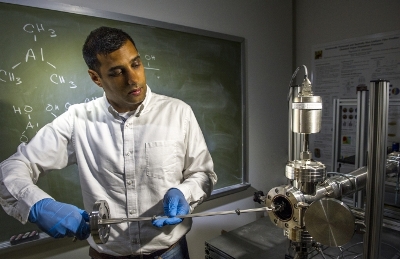Nov 16 2013
Creating thin films using a rapidly evolving technology that promises to solve some of NASA's thorniest engineering challenges is a lot like baking a cake.
 NASA technologist Vivek Dwivedi, who has distinguished himself as the go-to-engineer for atomic layer deposition, has assembled a new reactor at NASA’s Goddard Space Flight Center that he plans to use for thin-film experimentation. He is inserting one of his "virtual toothpick" technologies. Image Credit: NASA Goddard/Bill Hrybyk
NASA technologist Vivek Dwivedi, who has distinguished himself as the go-to-engineer for atomic layer deposition, has assembled a new reactor at NASA’s Goddard Space Flight Center that he plans to use for thin-film experimentation. He is inserting one of his "virtual toothpick" technologies. Image Credit: NASA Goddard/Bill Hrybyk
That's why Vivek Dwivedi, a technologist at NASA's Goddard Space Flight Center in Greenbelt, Md., has assembled a special "oven" and a "virtual toothpick" to monitor the progress of his confections.
The technology, called atomic layer deposition or ALD, is one of many techniques for applying thin films, which among other applications can improve computer memory, protect materials against corrosion, oxidation, and wear, and perform as batteries when deposited directly onto chips. It involves placing a substrate material inside a reactor chamber, which can be likened to an oven, and sequentially pulsing different types of precursor gases to create an ultra-thin film whose layers are literally no thicker than a single atom.
Although other thin-film deposition techniques exist, ALD offers an advantage over competing approaches. It can deposit films inside pores and cavities, giving ALD the unique ability to coat in and around three-dimensional objects, which is important to NASA scientists who fly complex, three-dimensional instrument components, like baffles. Baffles are devices that help restrain fluid, gas or loose material, or prevent sound or light from spreading in a certain direction.
Given ALD's vast potential for helping to downsize instrument size and increase efficiency, Goddard technologists now are developing in-house tools to more cost effectively experiment with the technique and investigate its usefulness in a variety of space applications.
'Like Baking a Cake'
Dwivedi has built an inexpensive, relatively simple reactor chamber that measures 3 inches in diameter and 2 feet in length, as well as a suite of monitoring tools that he collectively calls his virtual toothpick. "In my mind, it's a simple process," said Dwivedi, Goddard's resident expert in ALD. "But we have to make sure everything is being done under the right conditions. It's like baking a cake."
As with baking, creating thin films using ALD requires the perfect recipe, executed under exacting conditions. In addition to choosing the gas, selected because of its properties and the job the resulting film is supposed to perform, technologists must determine how long to flow the gas inside the chamber and at what temperature and pressure level.
"What we do is place the substrate or sample inside the reactor and follow the recipe. We also cross our fingers and hope the recipe is successful. It can be a time-consuming process," Dwivedi said. When depositing iridium to coat an X-ray mirror, for example, Dwivedi said he had to wait 24 hours to see if he had succeeded.
That's why he decided to augment his reactor with the virtual toothpick, a suite of tools he uses to monitor the process in real time and test to see if his confection is done.
The Tool Set
The tool set includes a modeling program to determine how much gas to deposit on the substrate or component, a quartz crystal microbalance to actually measure the thickness of the film being deposited, and a residual gas analyzer that detects the gases that flow through the reactor, both reacted and unreacted. "These tools save time," Dwivedi said, adding he can determine in real time how well the deposition is progressing.
They also save money, he added. One gram of an iron precursor gas used to create a film can cost as much as $1,000. "We have a responsibility to use money in a cost-effective manner. So we certainly don't want to waste material in trial and error," Dwivedi said.
"What we've done is develop a less-expensive platform and tools with which to experiment," he added. "This reactor gives us an advanced processing tool, which will allow us to investigate new material systems at a fraction of the cost."